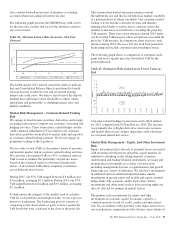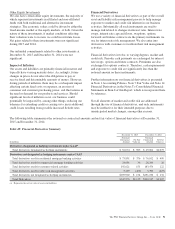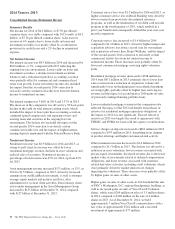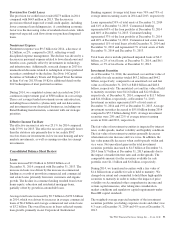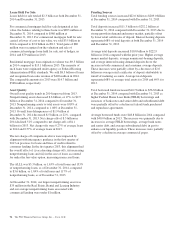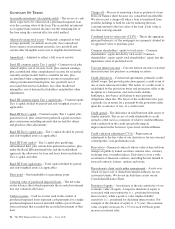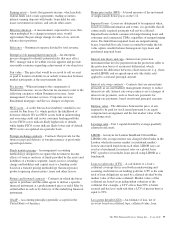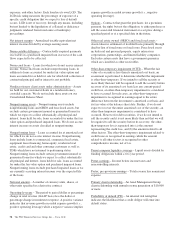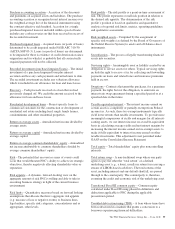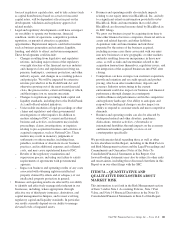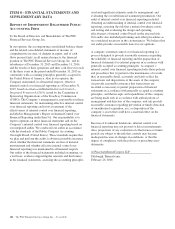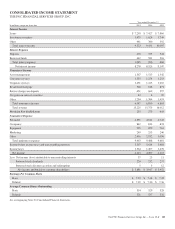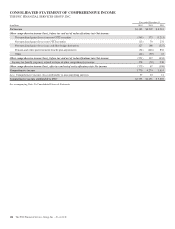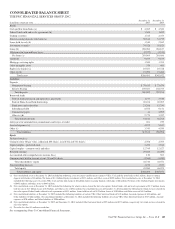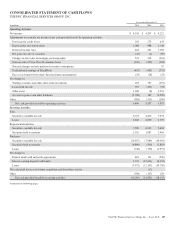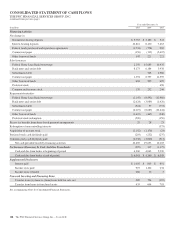PNC Bank 2015 Annual Report Download - page 117
Download and view the complete annual report
Please find page 117 of the 2015 PNC Bank annual report below. You can navigate through the pages in the report by either clicking on the pages listed below, or by using the keyword search tool below to find specific information within the annual report.
Purchase accounting accretion – Accretion of the discounts
and premiums on acquired assets and liabilities. The purchase
accounting accretion is recognized in net interest income over
the weighted-average life of the financial instruments using
the constant effective yield method. Accretion for a single
purchased impaired loan not included within a pool of loans
includes any cash recoveries on that loan received in excess of
the recorded investment.
Purchased impaired loans – Acquired loans (or pools of loans)
determined to be credit impaired under FASB ASC 310-30
(AICPA SOP 03-3). Loans (or pools of loans) are determined
to be impaired if there is evidence of credit deterioration since
origination and for which it is probable that all contractually
required payments will not be collected.
Recorded investment (purchased impaired loans) – The initial
investment of a purchased impaired loan plus interest
accretion and less any cash payments and writedowns to date.
The recorded investment excludes any valuation allowance
which is included in our allowance for loan and lease losses.
Recovery – Cash proceeds received on a loan that we had
previously charged off. We credit the amount received to the
allowance for loan and lease losses.
Residential development loans – Project-specific loans to
commercial customers for the construction or development of
residential real estate including land, single family homes,
condominiums and other residential properties.
Return on average assets – Annualized net income divided by
average assets.
Return on average capital – Annualized net income divided by
average capital.
Return on average common shareholders’ equity – Annualized
net income attributable to common shareholders divided by
average common shareholders’ equity.
Risk – The potential that an event or series of events could
occur that would threaten PNC’s ability to achieve its strategic
objectives, thereby negatively affecting shareholder value or
reputation.
Risk appetite – A dynamic, forward-looking view on the
aggregate amount of risk PNC is willing and able to take in
executing business strategy in light of the current business
environment.
Risk limits – Quantitative measures based on forward looking
assumptions that allocate the firm’s aggregate risk appetite
(e.g. measure of loss or negative events) to business lines,
legal entities, specific risk categories, concentrations and as
appropriate, other levels.
Risk profile – The risk profile is a point-in-time assessment of
risk. The profile represents overall risk position in relation to
the desired risk appetite. The determination of the risk
profile’s position is based on qualitative and quantitative
analysis of reported risk limits, metrics, operating guidelines
and qualitative assessments.
Risk-weighted assets – Computed by the assignment of
specific risk-weights (as defined by the Board of Governors of
the Federal Reserve System) to assets and off-balance sheet
instruments.
Securitization – The process of legally transforming financial
assets into securities.
Servicing rights – An intangible asset or liability created by an
obligation to service assets for others. Typical servicing rights
include the right to receive a fee for collecting and forwarding
payments on loans and related taxes and insurance premiums
held in escrow.
Swaptions – Contracts that grant the purchaser, for a premium
payment, the right, but not the obligation, to enter into an
interest rate swap agreement during a specified period or at a
specified date in the future.
Taxable-equivalent interest – The interest income earned on
certain assets is completely or partially exempt from Federal
income tax. As such, these tax-exempt instruments typically
yield lower returns than taxable investments. To provide more
meaningful comparisons of yields and margins for all interest-
earning assets, we use interest income on a taxable-equivalent
basis in calculating average yields and net interest margins by
increasing the interest income earned on tax-exempt assets to
make it fully equivalent to interest income earned on other
taxable investments. This adjustment is not permitted under
GAAP on the Consolidated Income Statement.
Total equity – Total shareholders’ equity plus noncontrolling
interests.
Total return swap – A non-traditional swap where one party
agrees to pay the other the “total return” of a defined
underlying asset (e.g., a loan), usually in return for receiving a
stream of LIBOR-based cash flows. The total returns of the
asset, including interest and any default shortfall, are passed
through to the counterparty. The counterparty is, therefore,
assuming the credit and economic risk of the underlying asset.
Transitional Basel III common equity – Common equity
calculated under Basel III using phased in definitions and
deductions applicable to PNC during the applicable
presentation period.
Troubled debt restructuring (TDR) – A loan whose terms have
been restructured in a manner that grants a concession to a
borrower experiencing financial difficulties.
The PNC Financial Services Group, Inc. – Form 10-K 99


